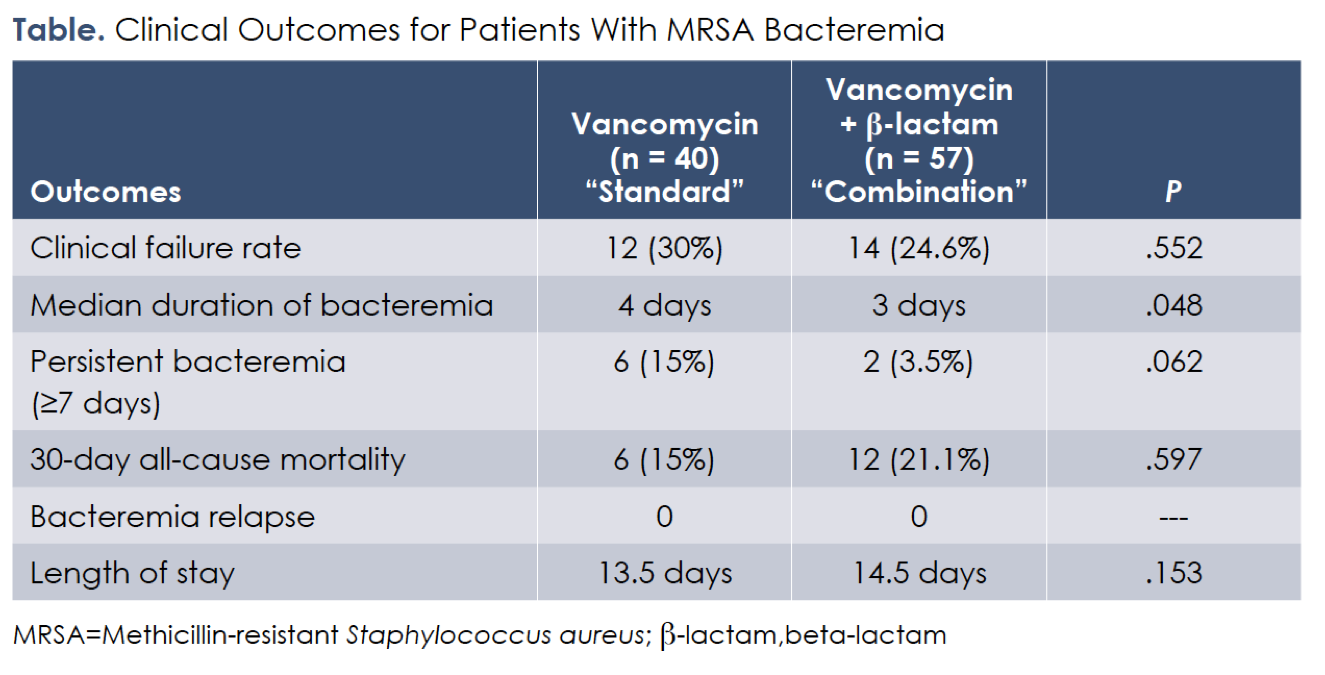Clinical Outcomes of Vancomycin Mono or Combination Therapy with a Beta-Lactam Against MRSA Bacteremia
Methicillin-resistant Staphylococcus aureus (MRSA) bacteremia is associated with high mortality.
Methicillin-resistant Staphylococcus aureus (MRSA) bacteremia is associated with high mortality, upward of 23.8% to 33%.1-4 Although treatment with vancomycin is considered the standard of care, its effectiveness against complicated MRSA infections has been questioned. Synergy against MRSA has been shown between beta-lactams (β-lactam) and vancomycin in vitro,5-9 but there are limited clinical data to substantiate these in vitro studies.
Casapao and colleagues evaluated a β-lactam plus vancomycin (combination group) compared with vancomycin monotherapy (standard group) for MRSA bacteremia at 5 US hospitals.10 Patients required at least 72 hours of vancomycin and at least 48 hours of the β-lactam to be considered for inclusion. Ninety-seven patients were evaluated. Baseline characteristics were similar between groups, with a few exceptions: patients in the standard therapy group were older (68 vs 62 years; P = .031), more likely to have a history of cerebrovascular accident (12 vs 4 patients; P = .005), received earlier infectious diseases consults (2 vs 3 days; P = .046), and in hospitals smaller than 300 beds (15 vs 11, P = .046).
The most common β-lactam received was piperacillin/tazobactam (54.4%), followed by cefepime (19.3%) and ceftriaxone (12.3%). The median vancomycin troughs were 15.0 mg/L in the standard group and 16.1 mg/L in the combination group (P = .262). Clinical outcomes are summarized in the Table. Briefly, clinical failure rates were 30% and 24.6% (P = .552) and the median duration of bacteremia was 4 and 3 days (P = .048) for the standard and combination groups, respectively. There was no statistical difference between the rates of persistent bacteremia or nephrotoxicity using either the vancomycin consensus guidelines, Acute Kidney Injury Network, or the risk, injury, failure, loss, and end-stage kidney disease (RIFLE) criteria). A multivariate analysis found that antibiotics discontinued prior to discharge (odds ratio [OR], 45.404; P <.001) and complicated bacteremia (OR, 6.856; P = .008) were associated with clinical failure whereas combination therapy was inversely correlated with clinical failure (OR, 0.237; P = .047).
This study retrospectively evaluated vancomycin alone or combined with a β-lactam for the treatment of MRSA bacteremia. While the duration of bacteremia was shortened by 1 day, there was no appreciable difference in mortality or failure rates. The clinical significance of shortening duration of bacteremia remains uncertain. The combination of vancomycin plus a β-lactam for MRSA bacteremia warrants further research in a larger patient population before it can be routinely applied to patient care.

References:
- Chu VH, Crosslin DR, Friedman JY et al. Staphylococcus aureus bacteremia in patients with prosthetic devices: costs and outcomes. Am J Med. 2005;118(12):1416.
- Cosgrove SE, Sakoulas G, Perencevich EN, Schwaber MJ, Karchmer AW, Carmeli Y. Comparison of mortality associated with methicillin resistant and methicillin susceptible Staphylococcus aureus bacteremia: a meta analysis. Clin Infect Dis. 2003;36(1):53-59.
- Whitby M, McLaws ML, Berry G. Risk of death from methicillin resistant Staphylococcus aureus bacteremia: a meta-analysis. Med J Aust. 2001;175(5):264-267.
- Simor AE, Pelude L, Golding G, et al; Canadian Nosocomial Infection Surveillance Program. Determinants of outcome in hospitalized patients with methicillin resistant Staphylococcus aureus bloodstream infections: results from national surveillance in Canada, 2008-2012. Infect Control Hosp Epidemiol. 2016;37(4):390-397. doi: 10.1017/ice.2015.323.
- Davis JS, Van Hal S, Tong SY. Combination antibiotic treatment of serious methicillin-resistant Staphylococcus aureus infections. Semin Respir Crit Care Med. 2015;36(1):3-16. doi: 10.1055/s-0034-1396906.
- Hagihara M, Wiskirchen DE, Kuti JL, Nicolau DP. In vitro pharmacodynamics of vancomycin and cefazolin alone and in combination against methicillin-resistant Staphylococcus aureus. Antimicrob Agents Chemother. 2012;56(1):202-207. doi: 10.1128/AAC.05473-11.
- Dilworth TJ, Leonard SN, Vilay AM, Mercier RC. Vancomycin and piperacillin-tazobactam against methicillin-resistant Staphylococcus aureus and vancomycin-intermediate Staphylococcus aureus isolates and vancomycin-intermediate S. aureus isolates in an vitro pharmacokinetic/pharmacodynamic model. Antimicrob Agents Chemother. 2014;36:1334-44.
- Dilworth TJ, Sliwinski J, Ryan K, Dodd M, Mercier RC. Evaluation of vancomycin in combination with piperacillin-tazobactam or oxacillin against clinical methicillin-resistant and vancomycin-intermediate Staphylococcus aureus isolates in vitro. Antimicrob Agents Chemother. 2014;58(2):1028-1033. doi: 10.1128/AAC.01888-13.
- Leonard SN. Synergy between vancomycin and nafcillin against Staphylococcus aureus in an in vitro pharmacokinetic/pharmacodynamics model. PLoS One. 2012;7:e42103. journals.plos.org/plosone/article?id=10.1371/journal.pone.0042103. Published July 24, 2012. Accessed January 1, 2018.
- Casapao AM, Jacobs DM, Bowers DR, Beyda ND, Dilworth TJ; REACH-ID Study Group. Early administration of adjuvant β-lactam therapy in combination with vancomycin among patients with methicillin-resistant Staphylococcus aureus bloodstream infection: a retrospective, multicenter analysis. Pharmacotherapy. 2017;37(11): 1347-1356. doi: 10.1002/phar.2034.
